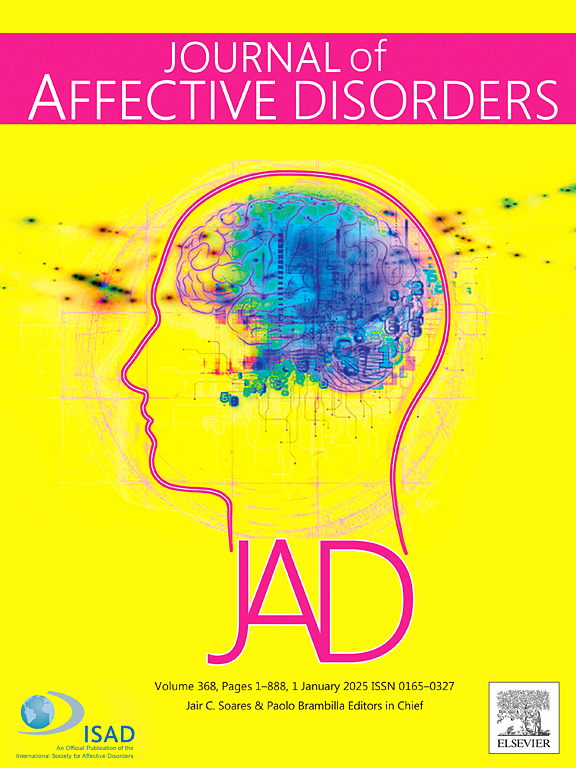Activation differentiates illness trajectories among youth seeking mental health care
IF 4.9
2区 医学
Q1 CLINICAL NEUROLOGY
引用次数: 0
Abstract
Background
The clinical profiles of youth presenting to early intervention mental health services are heterogeneous, with various sub-groups proposed and little information about the longitudinal stability of profiles, especially those associated with bipolarity.
Methods
802 youth aged 12–25-years (Mean = 18.26; 66 % females) accessing primary-care based mental health clinics were assessed at baseline and 417 were re-assessed after 12-months. An exploratory factor analysis of 62 items from six validated rating scales of the severity of mental and physical ill-health was conducted. Seven factors (anxiety, sleep, depression, restlessness, distress, activation, somatic complaints) were derived and modelled using latent profile analysis. Associations between profile membership, clinical outcomes and functioning were examined. Conditional probabilities of shifting to a different profile longitudinally were computed.
Results
Three profiles were revealed which were psychometrically invariant across baseline and follow-up: (1) ‘High distress with high activation’ (32 % baseline, 25 % follow-up); (2) ‘High distress without activation’ (31 % baseline, 26 % follow-up); and (3) ‘Moderate distress’ (37 % baseline, 33 % follow-up). A fourth profile, ‘Low distress’ (16 %), emerged at follow-up. Profiles did not differ by age at baseline or sex. ‘High distress with high activation’ was more likely to be impaired longitudinally, and to meet criteria for a full-threshold mental disorder at follow-up. About 39 % of youth retained the same profile longitudinally, while 16 % shifted to lower distress, and 13 % shifted to higher distress.
Conclusion
These findings suggest that activation is a marker of poorer clinical and functional outcomes in youth presenting for mental health care.
背景:方法:对 802 名 12-25 岁的青少年(平均年龄为 18.26 岁;66% 为女性)进行了基线评估,并在 12 个月后对 417 名青少年进行了再次评估。对精神和身体健康严重程度量表的六个有效评分量表中的 62 个项目进行了探索性因子分析。得出了七个因子(焦虑、睡眠、抑郁、烦躁不安、苦恼、激活、躯体不适),并使用潜在特征分析法建立了模型。研究考察了特征成员、临床结果和功能之间的关联。结果:结果表明,在基线和随访期间,有三个心理测量不变的特征:(1) "高痛苦、高激活"(基线比例为 32%,随访比例为 25%);(2) "高痛苦、无激活"(基线比例为 31%,随访比例为 26%);(3) "中度痛苦"(基线比例为 37%,随访比例为 33%)。第四种情况是 "低度痛苦"(16%),在随访中出现。不同年龄和性别的人的情况没有差异。高度痛苦和高度激活 "更有可能在纵向上受到影响,也更有可能在随访时达到完全阈值精神障碍的标准。约 39% 的青少年在纵向上保持了相同的特征,16% 的青少年转为较低的困扰,13% 的青少年转为较高的困扰:这些研究结果表明,在接受精神健康护理的青少年中,激活是临床和功能结果较差的一个标志。
本文章由计算机程序翻译,如有差异,请以英文原文为准。
求助全文
约1分钟内获得全文
求助全文
来源期刊

Journal of affective disorders
医学-精神病学
CiteScore
10.90
自引率
6.10%
发文量
1319
审稿时长
9.3 weeks
期刊介绍:
The Journal of Affective Disorders publishes papers concerned with affective disorders in the widest sense: depression, mania, mood spectrum, emotions and personality, anxiety and stress. It is interdisciplinary and aims to bring together different approaches for a diverse readership. Top quality papers will be accepted dealing with any aspect of affective disorders, including neuroimaging, cognitive neurosciences, genetics, molecular biology, experimental and clinical neurosciences, pharmacology, neuroimmunoendocrinology, intervention and treatment trials.
 求助内容:
求助内容: 应助结果提醒方式:
应助结果提醒方式:


